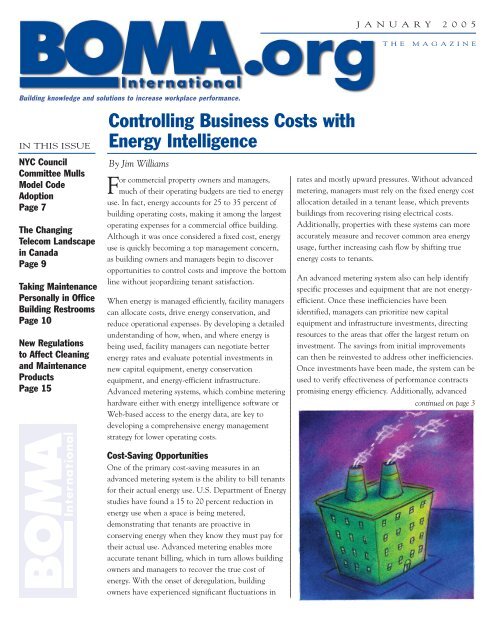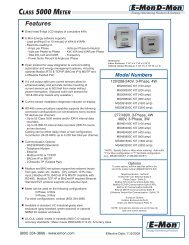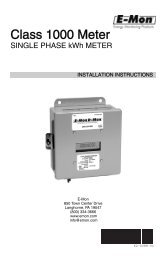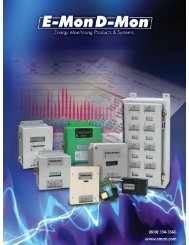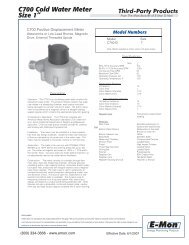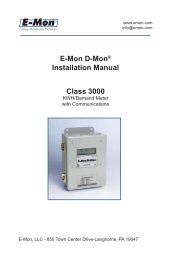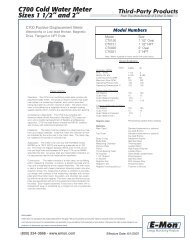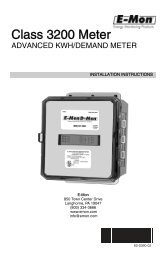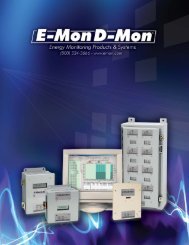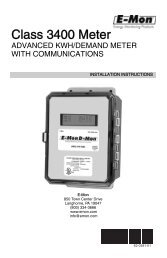Create successful ePaper yourself
Turn your PDF publications into a flip-book with our unique Google optimized e-Paper software.
JANUARY 2005<br />
THE MAGAZINE<br />
Building knowledge and solutions to increase workplace performance.<br />
IN THIS ISSUE<br />
NYC Council<br />
Committee Mulls<br />
Model Code<br />
Adoption<br />
Page 7<br />
The Changing<br />
Telecom Landscape<br />
in Canada<br />
Page 9<br />
Taking Maintenance<br />
Personally in Office<br />
Building Restrooms<br />
Page 10<br />
New Regulations<br />
to Affect Cleaning<br />
and Maintenance<br />
Products<br />
Page 15<br />
Controlling Business Costs with<br />
Energy Intelligence<br />
By Jim Williams<br />
For commercial property owners and managers,<br />
much of their operating budgets are tied to energy<br />
use. In fact, energy accounts for 25 to 35 percent of<br />
building operating costs, making it among the largest<br />
operating expenses for a commercial office building.<br />
Although it was once considered a fixed cost, energy<br />
use is quickly becoming a top management concern,<br />
as building owners and managers begin to discover<br />
opportunities to control costs and improve the bottom<br />
line without jeopardizing tenant satisfaction.<br />
When energy is managed efficiently, facility managers<br />
can allocate costs, drive energy conservation, and<br />
reduce operational expenses. By developing a detailed<br />
understanding of how, when, and where energy is<br />
being used, facility managers can negotiate better<br />
energy rates and evaluate potential investments in<br />
new capital equipment, energy conservation<br />
equipment, and energy-efficient infrastructure.<br />
Advanced metering systems, which combine metering<br />
hardware either with energy intelligence software or<br />
Web-based access to the energy data, are key to<br />
developing a comprehensive energy management<br />
strategy for lower operating costs.<br />
Cost-Saving Opportunities<br />
One of the primary cost-saving measures in an<br />
advanced metering system is the ability to bill tenants<br />
for their actual energy use. U.S. Department of Energy<br />
studies have found a 15 to 20 percent reduction in<br />
energy use when a space is being metered,<br />
demonstrating that tenants are proactive in<br />
conserving energy when they know they must pay for<br />
their actual use. Advanced metering enables more<br />
accurate tenant billing, which in turn allows building<br />
owners and managers to recover the true cost of<br />
energy. With the onset of deregulation, building<br />
owners have experienced significant fluctuations in<br />
rates and mostly upward pressures. Without advanced<br />
metering, managers must rely on the fixed energy cost<br />
allocation detailed in a tenant lease, which prevents<br />
buildings from recovering rising electrical costs.<br />
Additionally, properties with these systems can more<br />
accurately measure and recover common area energy<br />
usage, further increasing cash flow by shifting true<br />
energy costs to tenants.<br />
An advanced metering system also can help identify<br />
specific processes and equipment that are not energyefficient.<br />
Once these inefficiencies have been<br />
identified, managers can prioritize new capital<br />
equipment and infrastructure investments, directing<br />
resources to the areas that offer the largest return on<br />
investment. The savings from initial improvements<br />
can then be reinvested to address other inefficiencies.<br />
Once investments have been made, the system can be<br />
used to verify effectiveness of performance contracts<br />
promising energy efficiency. Additionally, advanced<br />
continued on page 3


